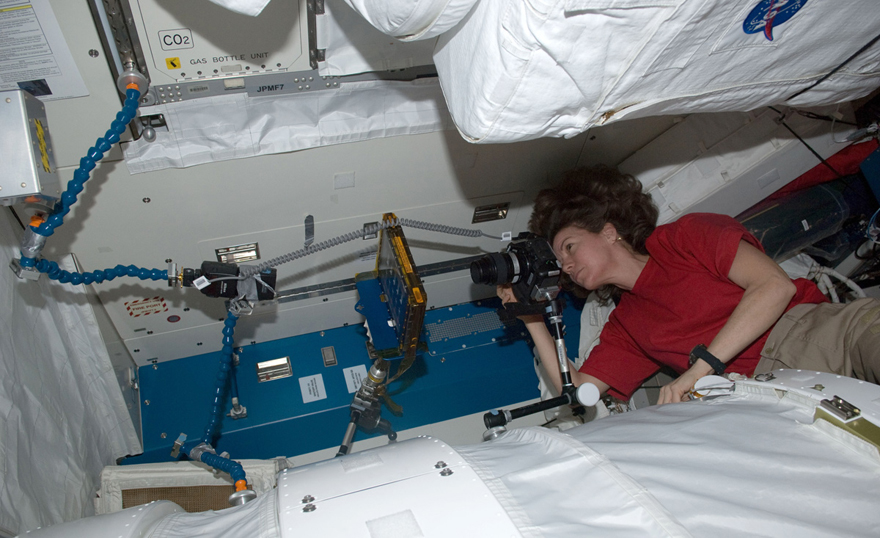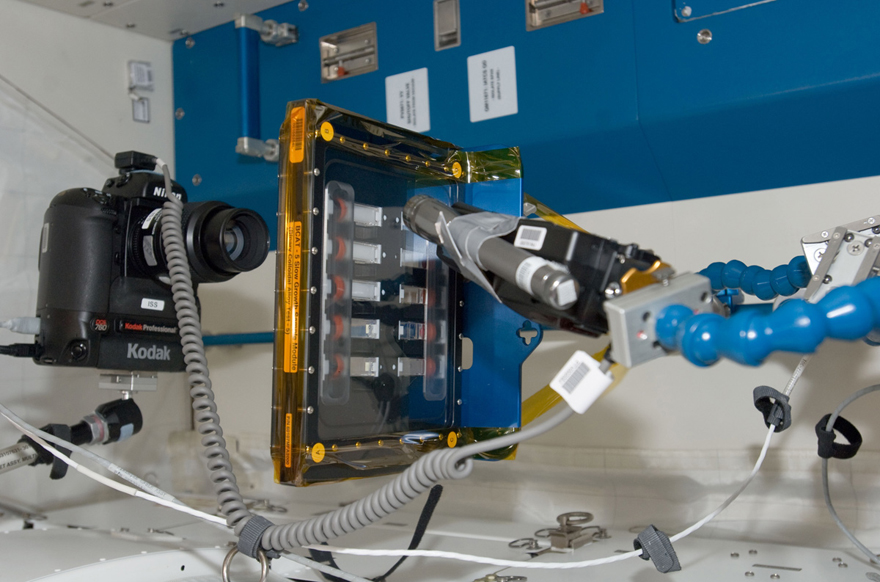Colloidal Science (BCAT-C1)
The Canadian Space Agency (CSA) astronaut Chris Hadfield describes BCAT-C1, a Canadian science mission that is being conducted on the International Space Station (ISS). Its first run began on January 23, 2013. (Credits: CSA, NASA)
Colloids: A brief explanation
Colloids. From the paint on your walls to your salad dressing, colloids are commonplace. But what is a colloid?
Colloids are particles distributed throughout a medium. The medium can be a solid, liquid or gas. To be considered a colloid, the particles must not be soluble in the medium. For instance, paint is colloidal material because it consists of pigment particles suspended in a liquid medium. It needs to be stirred to get the right consistency because in a resting state, the liquid and solid elements separate. Salad dressing is also a colloidal material because it consists of small oil particles dispersed in a watery medium. This is in contrast to a solution, a mixture in which the particles and the medium mingle. A soft drink is a solution because the sugar molecules dissolve in the water.
Colloids are also found in nature. Certain kinds of muddy water are colloidal, though they may appear to be solutions. Fine silt or clay particles do not dissolve in the medium of water, but will cloud it.
Colloids can also be the result of very sophisticated, technological processes. For instance, colloidal silver is sometimes inserted into other medical materials to act as an antibacterial agent.
Understanding how colloids react and interact is the goal of colloidal scientists. By controlling and fine-tuning colloids, they hope to eventually create innovations like paint that doesn't need to be mixed, mayonnaise with longer shelf-lives, and find new ways to process materials like plastics.
BCAT-C1 is a Canadian science mission that will be conducted on the ISS starting in August, 2012. It is a follow up to a CSA participation on the NASA sponsored BCAT-5, which took place in 2009-2010 on board the ISS.
BCAT-C1 will study nano-scale particles dispersed in a liquid, known as a colloidal suspension, commonly found in such commercial commodities as paint, electronic polishing compounds and food products. These suspensions have the unique property that they will phase separate (like oil and water) and the particles will self-assemble into crystals that interact strongly with light (like opal). Photographing these samples in microgravity will allow the measurement of these processes while avoiding the effects of particles sinking due to gravity. This study will allow the development of new insights into this important material process.
The Principal Investigators of BCAT-C1 are Barbara Frisken, a physics professor at Simon Fraser University (SFU), and Art Bailey of Canadian-based Scitech Instruments, Inc. They are responsible for seven of ten samples in the BCAT-C1 payload. New York University (NYU) has been invited to contribute the remaining three samples, also continuing research initiated on BCAT-5.The BCAT-C1 SFU experiment will study the behavior of colloidal particles when they undergo a phase change; in this case, when gas, liquid and crystal states in a colloidal suspension exist all at once. In particular, the SFU experiment will focus on a colloidal behavior observed for the first time during BCAT-5. The NYU experiments, on the other hand, will focus on seeded growth of crystals in microgravity.
Outcomes of the BCAT-C1 study might be applied to colloidal processes in the future, including finding innovative ways to produce plastics or extend the shelf-life of consumer products.
The BCAT-C1 hardware includes a clear acrylic case to house the ten experiment samples, a camera, a flash unit and various mounting components. To begin the study, an ISS crewmember will stir the samples with a magnet. A flash unit will illuminate them from behind, and the camera will capture time-lapse photographs of the colloids as they evolve over a period of ten days. The astronauts will be guided by the scientists and mission support team on the ground. It is expected that Canadian astronaut Chris Hadfield will perform part of this experiment during Expedition 34/35.

2011-02-03 - NASA astronaut Catherine Coleman takes a photo of the BCAT-5 hardware setup in the Japanese Kibo Module. (Credit: NASA)

The BCAT-5 experiment set up in the Japanese Kibo Module of the ISS. BCAT-C1 will look similar. (Credit: NASA)